Both the Netherlands and Canada have won their last two matches in the FIFA Women’s World Cup 2019. The two teams have it rather easy in the tournament with both teams collecting six points and qualifying to the round of 16 without much trouble.
Kenneth Heiner-Møller’s side have been brilliant, but so have Sarina Wiegman’s in this edition of FIFA Women’s World Cup. Their teams have both been aggressive in attack and solid in defence.
But who’s going to take the three points in the next game and finish top of the group? We’ll certainly see about that but before we do, here is a tactical preview to give you a slight image of how the tactical battle may unfold in this exciting fixture.
Both teams’ potential setup
Netherlands
The Netherlands used the same setup in their last two games – a 4-3-3 shape.
Wiegman made only one change in their last game against Cameroon with centre-back Anouk Dekker coming in to replace Stefanie van der Gragt who seemed to take a knock in the New Zealand game.
There doesn’t seem to be much change to be anticipated in the next game. But considering the fact that they have qualified to the next round, Wiegman may just choose to do some rotation.
Sari van Veenendaal has played in both matches against Cameroon and New Zealand. There’s a chance that she will be replaced by experienced goalkeeper Loes Geurts in the next match.
Desiree van Lunteren, Dominique Bloodworth, and Kika van Es have all been ever-present. Van Es could be starting in the next match although Merel van Dongen is always ready to step up whenever Wiegman calls on her. Meanwhile, Bloodworth and Van Lunteren are likely to start again in the next match.
Sherida Spitse, Jackie Groenen, and Danielle van de Donk have all played magnificently in the last two matches. There’s a big chance that defensive midfielder Spitse will start again on Thursday. One of the two centre-mids, however, may be rested in the next game. Jill Roord played brilliantly in the last two games, albeit only as a substitute. She even scored the one and only goal in their win against New Zealand. She definitely deserves a start in the next game, replacing either van de Donk or Groenen.
The Netherlands’ front three have been amazing as well so far. Especially Arsenal’s striker Vivianne Miedema who scored two goals against Cameroon in the last match. The complete forward took her goal tally to 60 to become the Netherlands’ all-time top scorer at the age of only 22.
Both Lieke Martens and Miedema may start again in the next game while there’s a chance for Lineth Beerensteyn to showcase her talents and start ahead of Shanice van de Sanden on Thursday.
Canada
Heiner-Møller deployed his team in two different systems in their last two games. Against Cameroon, they played with 4-3-3. Meanwhile, against New Zealand, they played in a 4-2-3-1 shape.
The manager made only one change in their last match against New Zealand with Jayde Riviere starting ahead of Allysha Chapman. Due to this change, Ashley Lawrence, who usually plays on the left side, moved to fill in the right-back spot.
There is also not much change to be anticipated. But considering they have secured a qualification, a gentle squad rotation might be in the offing.
Veteran goalkeeper Stephanie Labbe is the main choice for the goalkeeper berth and she’s been brilliant so far. It is looking very likely that she’ll start again in the next game.
The centre-back pair of Kadeisha Buchanan and Shelina Zadorsky have also been nothing less than terrific and they are looking more solid than ever. Lawrence is the first choice full-back and she might start again on Thursday. Either Riviere or Chapman will be her partner on the other side of the flank.
So far we haven’t seen any change in the midfield and attack and we probably aren’t going to see one in the next game unless an unwanted situation arise.
Desiree Scott has been a prominent figure at the centre of the field. Playing as a defensive midfielder, her ability to read situations as well as control the game are absolutely vital and she has proven her worth in the last two games.
Her partners in the midfield are Sophie Schmidt and Jessie Fleming who are also nothing but impressive so far in the tournament. These three women in the midfield will certainly cause some trouble for the Netherlands both in attack and defence.
Up front, Canada have got talented youngsters Nichelle Prince and Janine Beckie as well as the legendary Christine Sinclair. Prince have been playing great football in the tournament and she’s thoroughly enjoying it. She even scored the second goal in their 2-0 win against New Zealand. Canada do have other options in the attack with names like Adriana Leon and Jordyn Huitema ready to step up on Thursday.
Netherlands’ aggressive attack
Wiegman’s side build their play up in a rather quick fashion, but they love to play out from the back.
They tend to attack from the flanks and they also tend to deliver diagonal long balls from the back. Spitse and Bloodworth are usually the main protagonists when it comes to these diagonal forward passes.
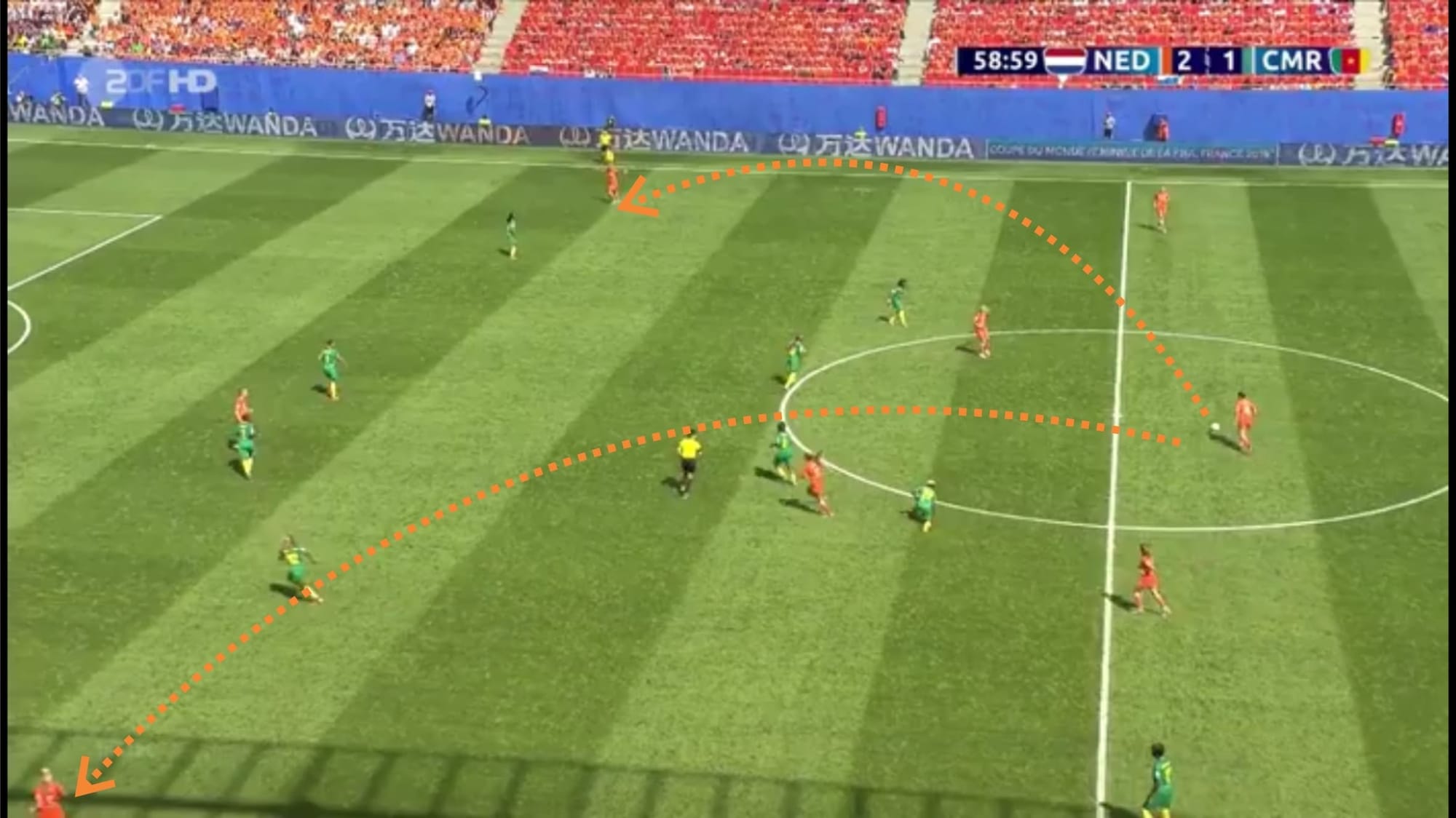
Cameroon’s narrow defensive line was a huge help as well as the wingers were given much more freedom and spaces to exploit.
The Netherlands tend to play rather patiently when the ball is in their own half, but seem to increase their tempo and intensity once they break out of the pressure. Spitse and co. are a bit struggling against teams who blocks high and press their defence aggressively. They seemed a bit prone to mistakes at the back, which at times, could be fatal. But if they managed to escape the pressure from the back, they’d instantly turn into a dangerous threat.
Canada should be very careful with the ball and try not to lose them in a dangerous position as the Netherlands are known to be extremely quick on the break.
Out of possession, Canada defends with a 4-4-2 structure. They are willing to stretch the shape out in order to prevent any wide attacks that come from the opponent. At the same time, they would try to keep the distance between the defensive and midfield line as narrow as possible. If they can’t, it will create vulnerable spaces between the lines and allow the opponent to capitalise.
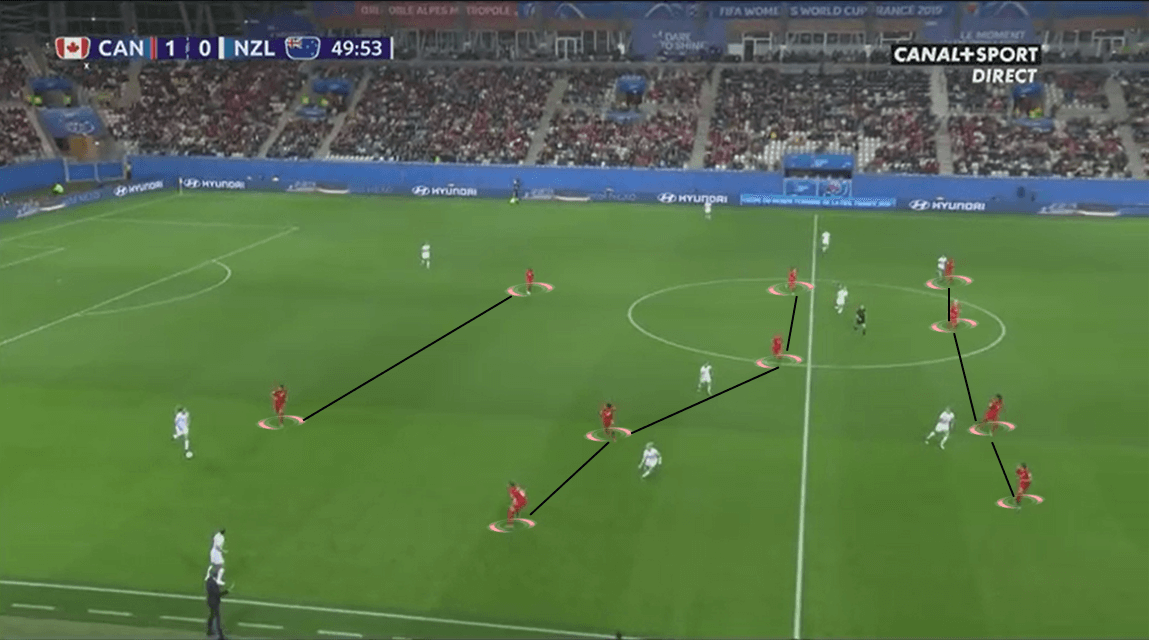
The North American side also adopt a man-oriented marking system. Inside the opponent’s half, a player would close down the ball carrier while signalling her teammates to join. Their responsibilities are to block surrounding passing options and be in an active state to intercept any passes coming towards them.
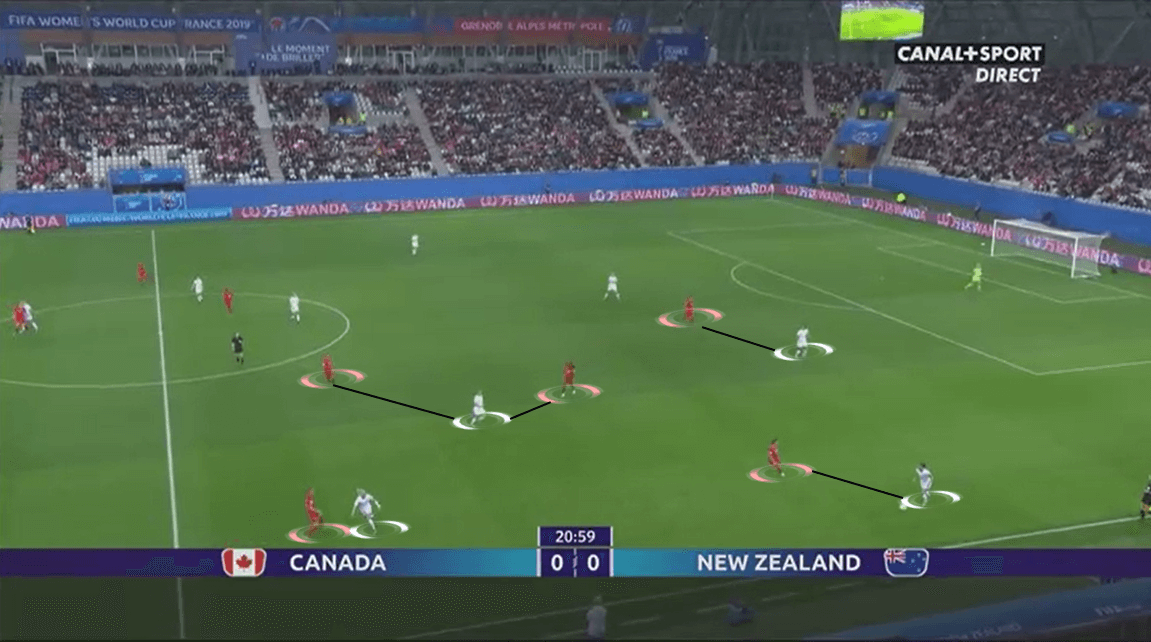
In the image above, we can easily notice that Canada had numerical superiority over New Zealand. The reason behind this strategy was to be ready to trigger the press. They aim to suffocate the ball carrier, prevent her from making any passes towards her teammates or even dribble her way out of trouble.
As mentioned above, the Netherlands struggle when playing against teams who press aggressively. Canada could exploit this weakness by using their aggressive press and recover possession high up the pitch. Two things that Wiegman’s side should also notice are Canada conceded one goal in eleven competitive matches and they are one of three sides that yet to be conceded.
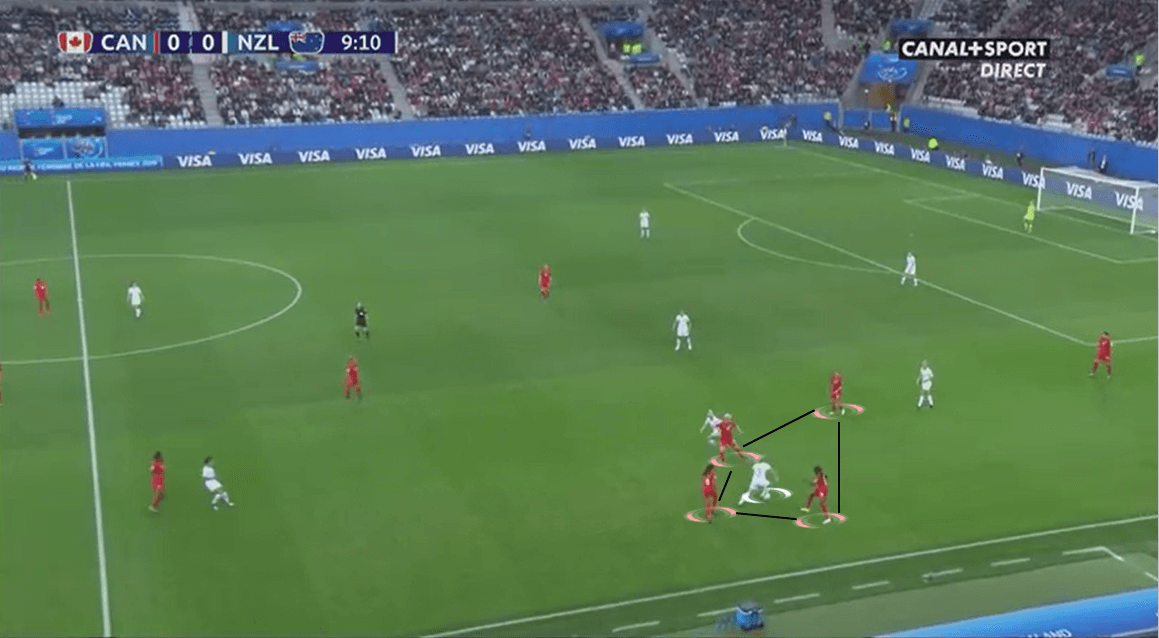
Anticipating the attacks
The Netherlands seem to defend with a mid-high block in their last two games. They also seemed to close down aggressively with their player-oriented pressing, but they didn’t to try to overload the flanks.
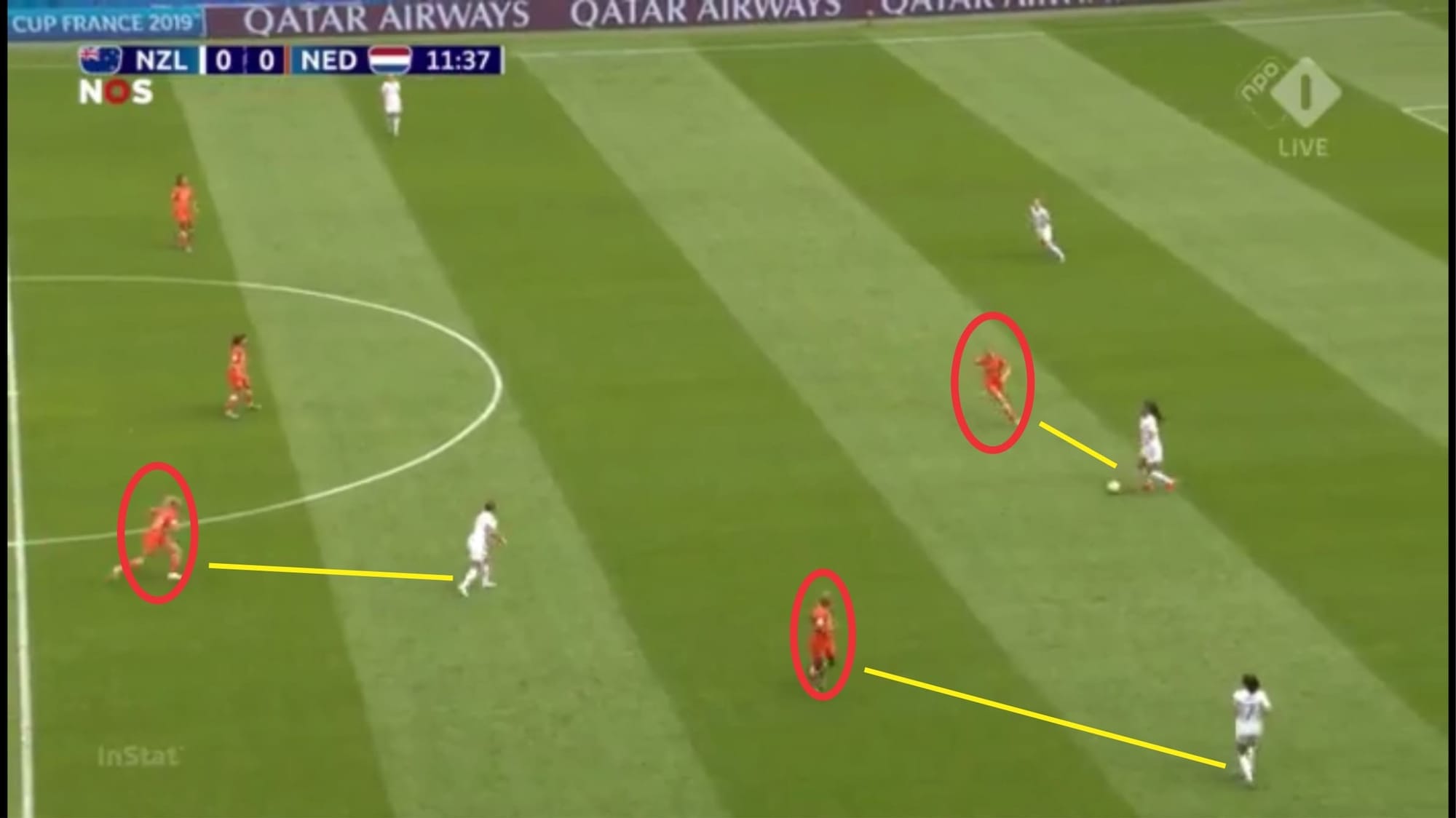
Wiegman seemed to want her side to focus on compressing the space in the middle in their last two games. But she might want to tweak her tactics a little bit in the upcoming game. Especially knowing that Canada tend to attack from the flanks.
On the opposite side, Heiner-Moller’s side also tend to play out from the back. With Sophie Schmidt willing to drop deep and form a passing triangle inside Canada’s half, the full-backs can locate themselves high up the pitch and ready for a diagonal long pass. This would turn their formation into a 3-1-4-2, and it also allows them to have numerical superiority in attack.
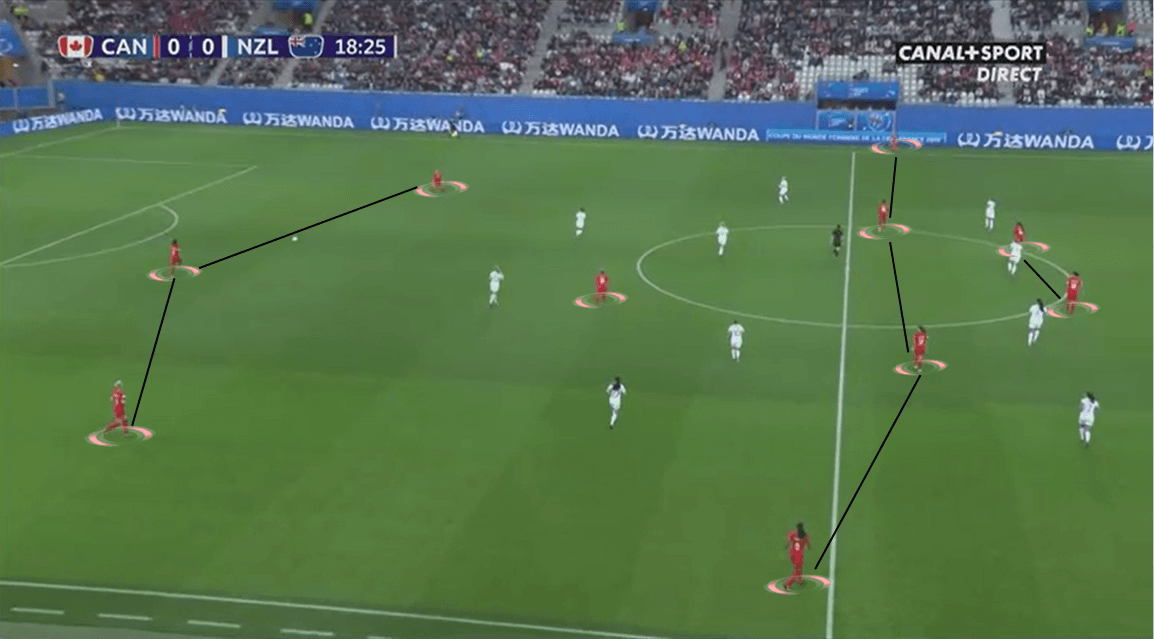
They favour short passes and opted not to make risky passes when unnecessary. As a result, their ball possessions in the last two games are pretty high, which stands at 65% and 70% respectively. Furthermore, their passing accuracies are also impressive with the lowest stood at 80% from the first match against Cameroon. The latter is 85% against New Zealand.
Canada usually distributes and start their attacks down the flanks. The appearance of Nichelle Prince and Janine Beckie is key for them as both can terrorise the opposition’s defence using their pace and dribbling ability. One of the perfect examples for the above statement is Jessie Fleming’s goal against New Zealand.
When the opponent attempted to overload the ball carrier’s area, they have to raise their defensive line to near the halfway line. Prince noticed this and located herself in free space but also available to pick up the ball. Using her pace, she beat the opponent’s defender and managed to make a cross for Fleming to open the score. It was a very lethal counter-attack and this could become one of Canada’s attacking methods.
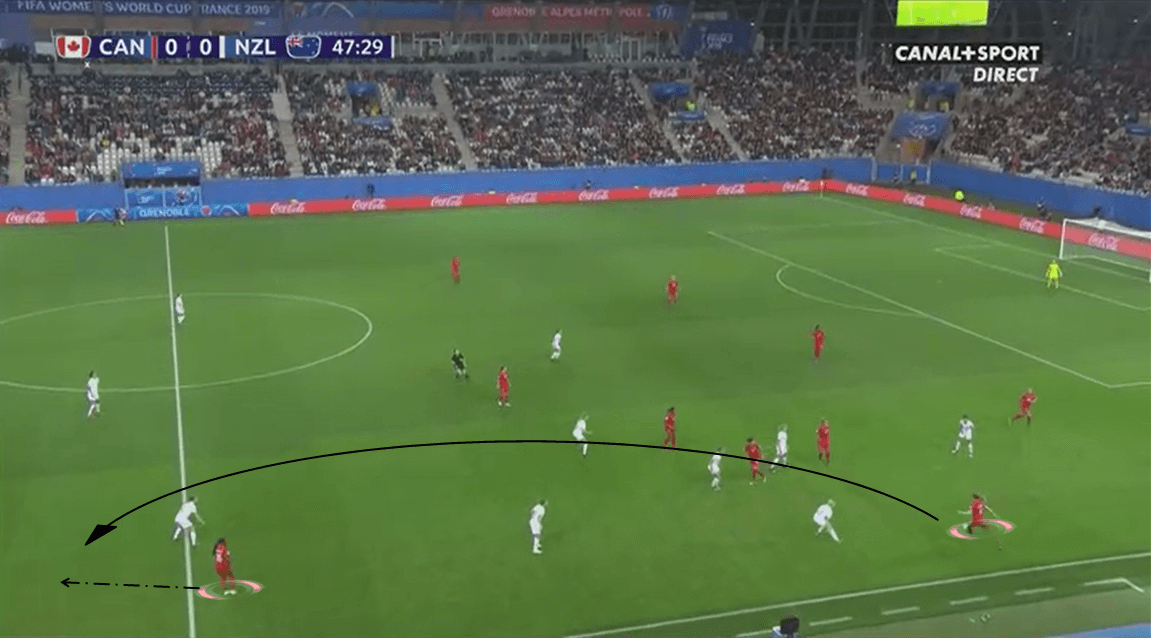
Overloading the flanks
The Netherlands have from time to time, proven their effectiveness when attacking through the flanks. But they have proven to be quite tame when the opposing team knows how to deal with their attacks.
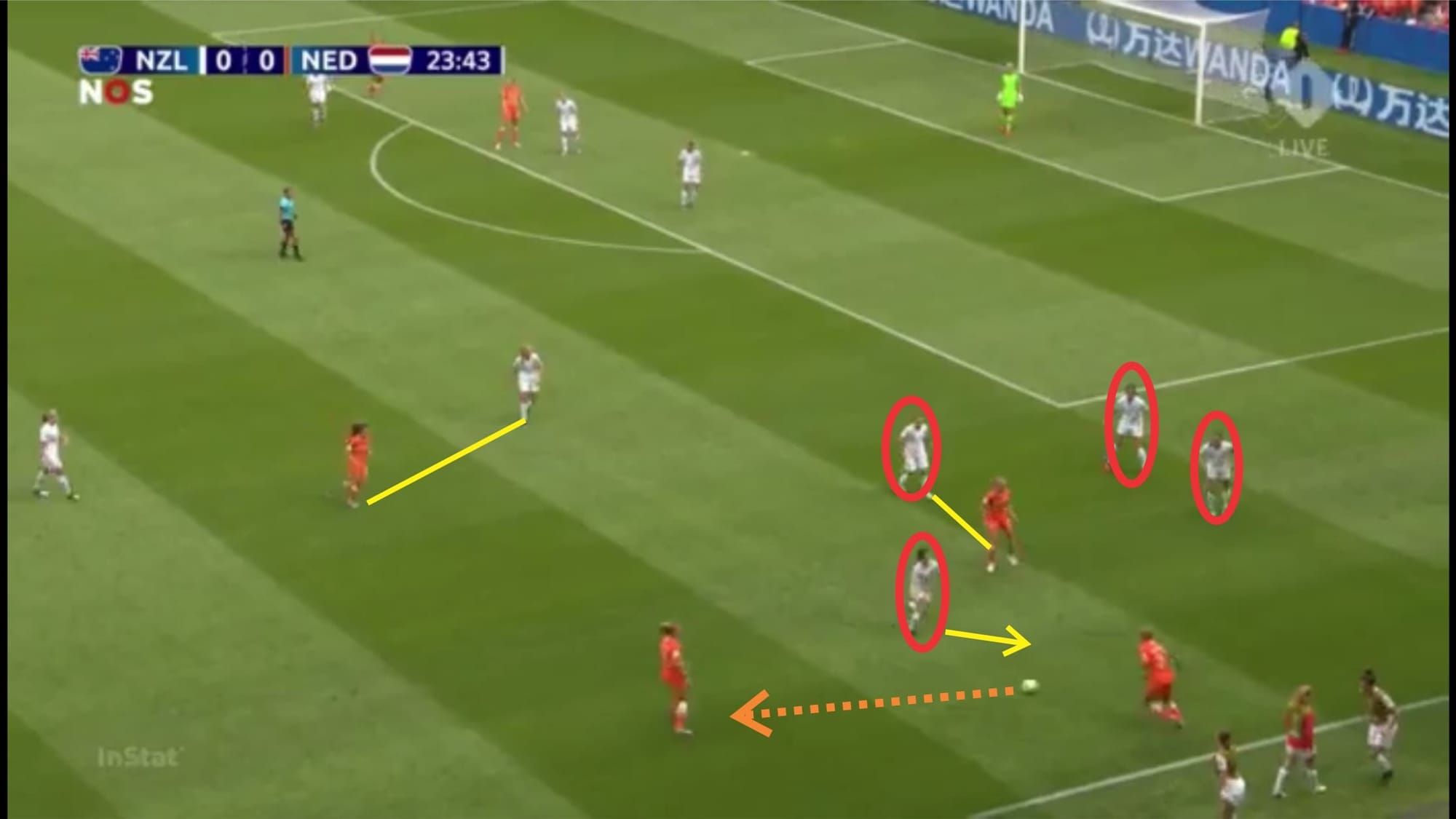
As we can see here New Zealand were overloading the right flank in order to shut down the Netherlands’ attacks. The New Zealand players were surrounding Groenen and marking the passing lane towards van de Sanden. At that situation, van Lunteren had no choice but to pass it to van de Donk in the middle or go back to the defence and recycle the ball.
This has proven to be extremely effective as the Netherlands were struggling to break New Zealand’s defence for most of the game. As a result, the Netherlands decided to break through centrally, launching passes into space with Miedema as the main target.
Against Cameroon, the Netherlands were given more freedom to exploit the flanks as the former tended to crowd the middle. In the end, two out of three Netherlands’ goals were the direct result of attacks from the flanks.
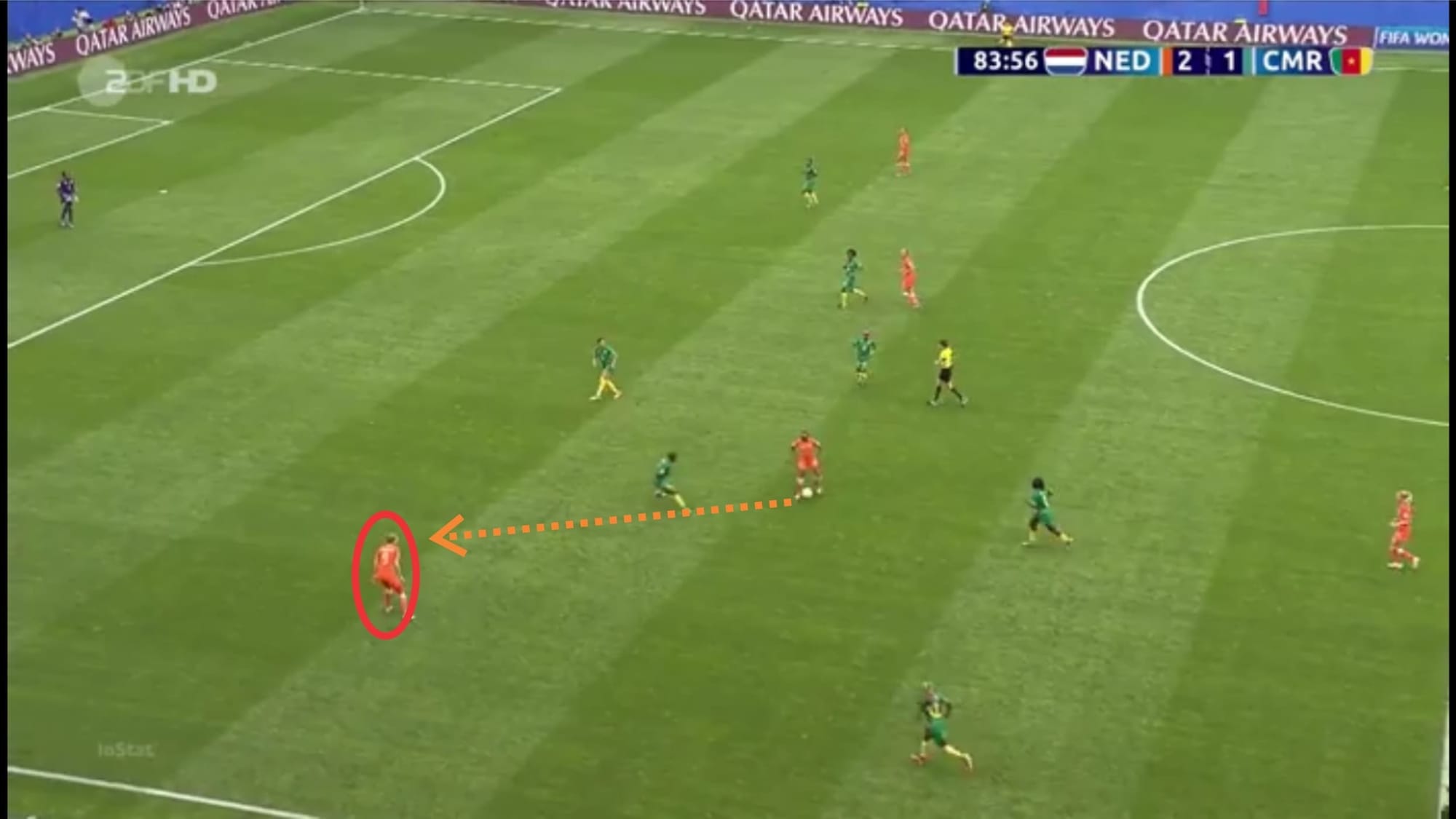
As good as Canada are when attacking down the wings, they can struggle if the opponent manages to overload the wide areas. New Zealand have applied this strategy in the first half and that was why Heiner-Moller’s side couldn’t find a way into Erin Nayler’s goal. When Jayde Riviere had the ball, three players immediately approached her and the surround teammates. This forced Riviere to make a back pass and restart the attack.
With the efficiency of New Zealand’s strategy, both Canada and the Netherlands could also adopt the same strategy in order to prevent the other from building their attacks down both sides of the pitch.
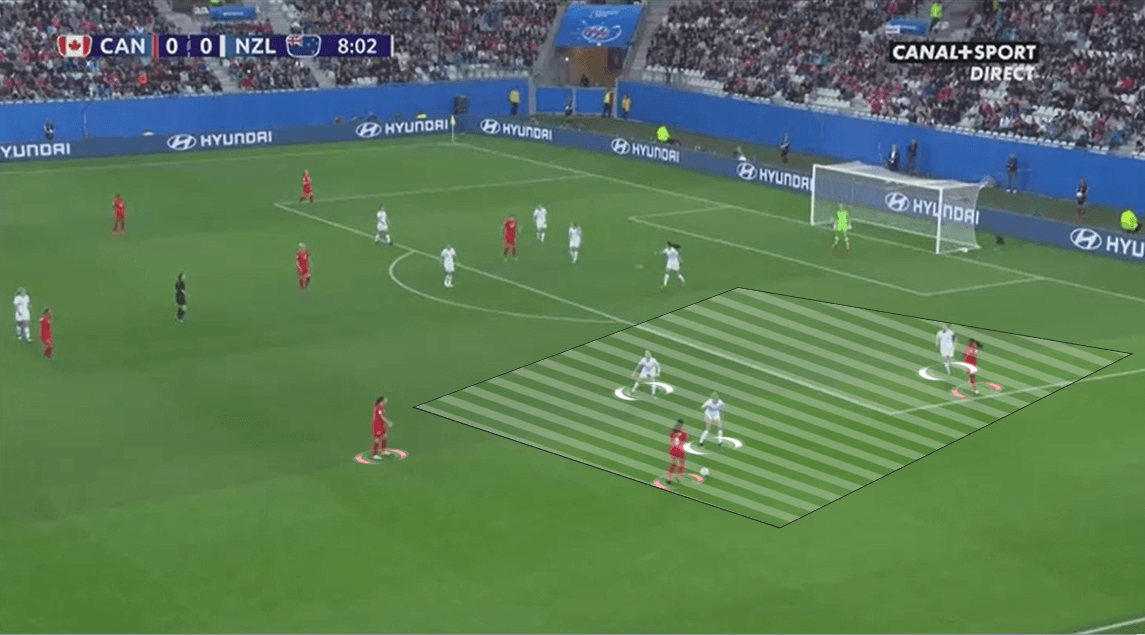
Relevant statistics
Both the Netherlands and Canada have won their last two matches in the FIFA Women’s World Cup 2019.
The Netherlands have scored four goals in just two games. That’s one against New Zealand and three in their last match against Cameroon. Of course, with a frontline containing the likes of van de Sanden, Martens, and Miedema, you’d expect to see this happening.
Three out of four goals were scored from open plays/positional attacks, while the other one was the indirect result of a free-kick.
De Oranje Leeuwinnen have collected a total of 3.32 xG from around nine chances in two games so far in the competition. Those numbers certainly showed how good they are in creating chances and how effective they have been in front of goal.
Wiegman’s side is also expected to attack mostly from the flanks with the left wing being their favourite side to attack. They averaged around 39 attacks from the left, 21 from the centre, and 37 from the right.
The Netherlands have conceded only one goal in the tournament so far. The goal was scored by Cameroon’s Gabrielle Onguene and it was the result of van Veenendaal’s poor judgment when rushing out.
Canada, on the other hand, have scored three goals in two games. That’s one against Cameroon and two against New Zealand.
Two out of three goals were the result of excellent positional attacks, while the other one was from a corner.
Despite that, Canada could perhaps be more effective in front of goal. From their last two games, they have collected around 4.8 xG from 12 chances. That means they have created lots of good chances, but need to do better at converting them into goals.
Canada’s attacks mostly come from the flanks with 40 of them coming from the right side, 18 from the centre, and 38 from the left.
Canada’s defence have also been magnificent. They have kept two consecutive clean sheets so far.
Conclusion
We’re expecting an exciting match ahead of Netherlands’ clash against Canada on Thursday. There could be some serious tactical battle on display in the upcoming game that could decide who finishes top of the table. Both teams have secured qualification to the next round and they duly deserved it, having played fantastically so far in the tournament.
The two teams face each other off again after their last meeting four years ago which ended in a 1-1 draw. Coincidentally, both also qualified to the round of 16 back then.
This occasion will be a big challenge for both teams respectively. Can the Netherlands break down Canada’s sturdy defence? Will Canada be able to weather the storm and hit the Netherlands back where it hurts?
Hopefully, this tactical preview gives you a clear image of how both teams might play in the upcoming game.
If you are following the FIFA Women’s World Cup 2019 then you will find our FREE tactical preview magazine the perfect compliment to the tournament. You can download it HERE – each nation is previewed and we also profile their key player and young player to watch. Enjoy!

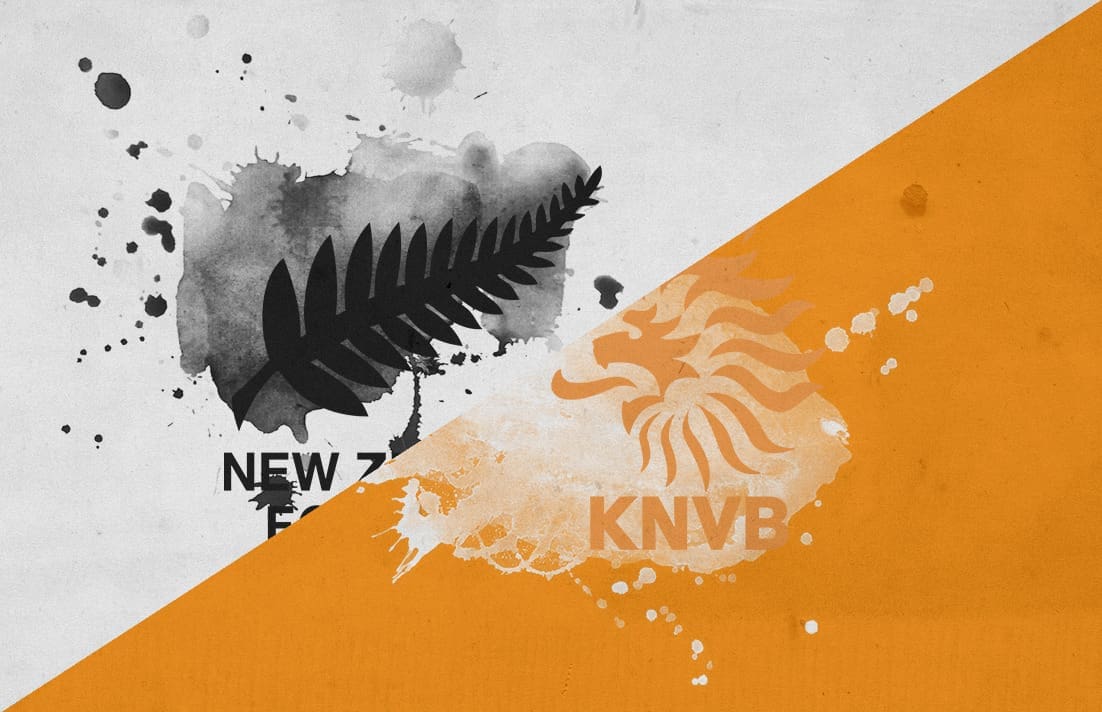



Comments